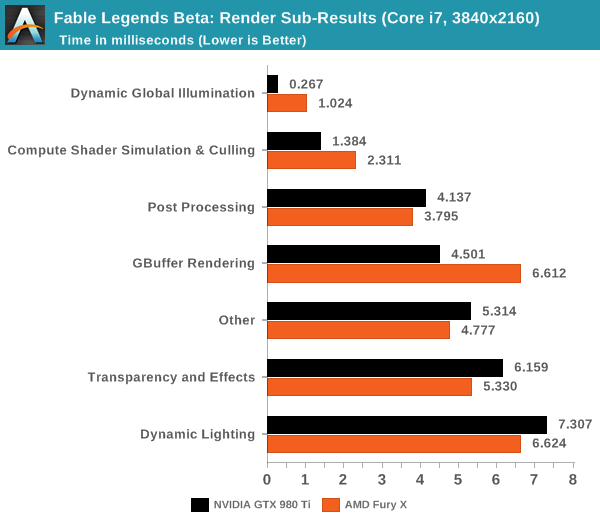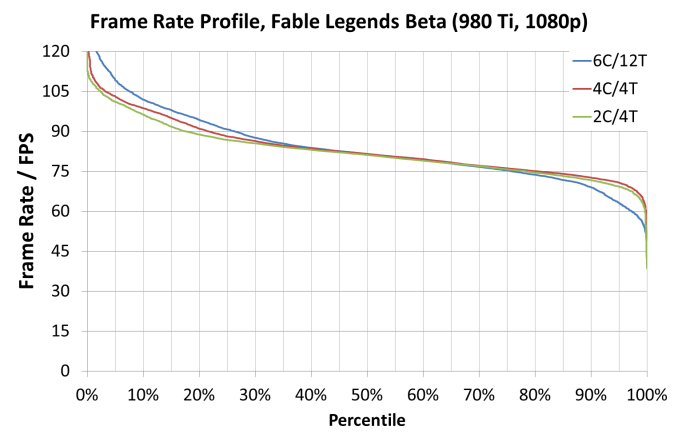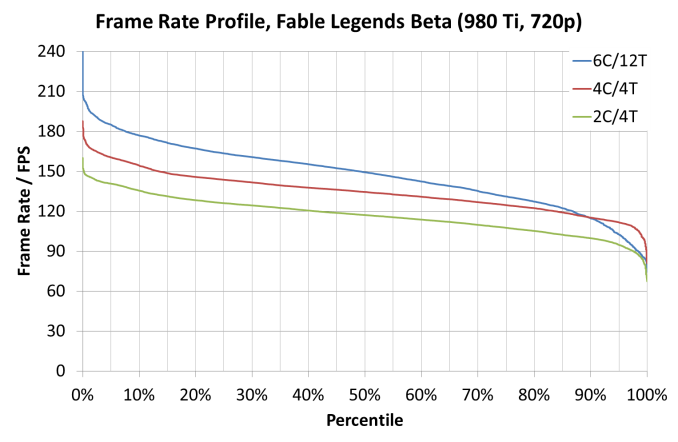Fable Legends Early Preview: DirectX 12 Benchmark Analysis
by Ryan Smith, Ian Cutress & Daniel Williams on September 24, 2015 9:00 AM ESTFinal Words
Non-final benchmarks are a tough element to define. On one hand, they do not show the full range of both performance and graphical enhancements and could be subject to critical rendering paths that cause performance issues. On the other side, they are near-final representations and aspirations of the game developers, with the game engine almost at the point of being comfortable. To say that a preview benchmark is somewhere from 50% to 90% representative of the final product is not much of a bold statement to make in these circumstances, but between those two numbers can be a world of difference.
Fable Legends, developed by Lionhead Studios and published by Microsoft, uses EPIC’s Unreal 4 engine. All the elements of that previous sentence have gravitas in the gaming industry: Fable is a well-known franchise, Lionhead is a successful game developer, Microsoft is Microsoft, and EPIC’s Unreal engines have powered triple-A gaming titles for the best part of two decades. With the right ingredients, therein lies the potential for that melt-in-the-mouth cake as long as the oven is set just right.
Convoluted cake metaphors aside, this article set out to test the new Fable Legends benchmark in DirectX 12. As it stands, the software build we received indicated that the benchmark and game is still in 'early access preview' mode, so improvements may happen down the line. Users are interested in how DX12 games will both perform and scale on different hardware and different settings, and we aimed to fill in some of those blanks today. We used several AMD and NVIDIA GPUs, mainly focusing on NVIDIA’s GTX 980 Ti and AMD’s Fury X, with Core i7-X (six cores with HyperThreading), Core i5 (quad core, no HT) and Core i3 (two cores, HT) system configurations. These two GPUs were also tested at 3840x2160 (4K) with Ultra settings, 1920x1080 with Ultra settings and 1280x720 with low settings.
On pure average frame rate numbers, we saw NVIDIA’s GTX 980 Ti by just under 10% in all configurations except for the 1280x720 settings which gave the Fury X a substantial (10%+ on i5 and i3) lead. Looking at CPU scaling, this showed that scaling only ever really occurred at the 1280x720 settings anyway, with both AMD and NVIDIA showing a 20-25% gain moving from a Core i3 to a Core i7. Some of the older cards showed a smaller 7% improvement over the same test.
Looking through the frame rate profile data, specifically looking for minimum benchmark percentile numbers, we saw an interesting correlation with using a Core i7 (six core, HT) platform and the frame rates on complex frames being beaten by the Core i5 and even the Core i3 setups, despite the fact that during the easier frames to compute the Core i7 performed better. In our graphs, it gave a tilted axis akin to a seesaw:
When comparing the separate compute profile time data provided by the benchmark, it showed that the Core i7 was taking longer for a few of the lighting techniques, perhaps relating to cache or scheduling issues either at the CPU end or the GPU end which was alleviated with fewer cores in the mix. This may come down to a memory controller not being bombarded with higher priority requests causing a shuffle in the data request queue.

When we do a direct comparison for AMD’s Fury X and NVIDIA’s GTX 980 Ti in the render sub-category results for 4K using a Core i7, both AMD and NVIDIA have their strong points in this benchmark. NVIDIA favors illumination, compute shader work and GBuffer rendering where AMD favors post processing, transparency and dynamic lighting.
DirectX 12 is coming in with new effects to make games look better with new features to allow developers to extract performance out of our hardware. Fable Legends uses EPIC’s Unreal Engine 4 with added effects and represents a multi-year effort to develop the engine around DX12's feature set and ultimately improve performance over DX11. With this benchmark we have begun to peek a little in to what actual graphics performance in games might be like, and if DX12 benefits users on low powered CPUs or high-end GPUs more. That being said, there is a good chance that the performance we’ve seen today will change by release due to driver updates and/or optimizing the game code. Nevertheless, at this point it does appear that a reasonably strong card such as the 290X or GTX 970 are needed to get a smooth 1080p experience (at Ultra settings) with this demo.














141 Comments
View All Comments
Alexvrb - Friday, September 25, 2015 - link
Ship them both to the East Coast and set up a Review Office / Beach Resort, complete with community events!zimanodenea - Thursday, September 24, 2015 - link
My Asus m5a97 has an option to do this.mdriftmeyer - Thursday, September 24, 2015 - link
Time to develop in a test harness of equal merits and scope across the globe for the reviewers. To do less is unprofessional. The whole point of a test harness is not to ductape simulations but to cover all bases.Spunjji - Friday, September 25, 2015 - link
Well said. This isn't some tinpot organisation, is it? ;)Drumsticks - Thursday, September 24, 2015 - link
That's a shame. I'd really like to see that comparison. With the improvements Zen should, in theory, bring, it could really give AMD its best chance in years to get some wind under its sails.beck2050 - Thursday, September 24, 2015 - link
A little too early to worry about. Hopefully both companies will improve when 12 becomes standard issue.DrKlahn - Thursday, September 24, 2015 - link
Epic has always worked closely with Nvidia and used their hardware, so the only thing that surprises me is that the gap doesn't favor Nvidia more. It's very early to make any predictions, but there are some interesting conversations on other forums about how both architectures behave in different situations. Nvidia's architecture does appear to have issues in some asynchronous workloads. What little evidence we have says this may be an issue in some games.My own opinion is that with Nvidia's market dominance we will see most developers try to avoid situations where problems occur. As an AMD owner my main hope is that we see DX12 squeeze out proprietary codes and level the playing field more. I'm also happy that the latest Unreal engine appears to run well on both vendors hardware.
jiao lu - Thursday, September 24, 2015 - link
not only close working relationship . the Unreal 3/4 use Nvidia Physics sdk outright. Epic engine is terribly optimized for console right now. basically it is PC engine, churn out pc demo now and then . Now far fewer AAA studio use unreal 4 like they do with unreal 3 in the ps 3/xbox 360 era. I am very much suspicious unreal 5 is not mult-threaded rendering enough , use dx 12 like do dx 11 before.Midwayman - Thursday, September 24, 2015 - link
Well, the xbox one is using AMD hardware and dx12. That's probably a bigger reason to keep it neutral than more nvidia share on the PC.Spunjji - Friday, September 25, 2015 - link
The PS4 is also using the same AMD GCN 1.0 architectures for CPU and GPU